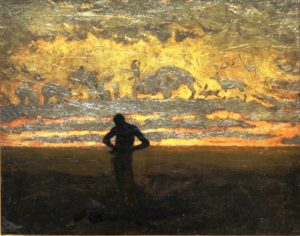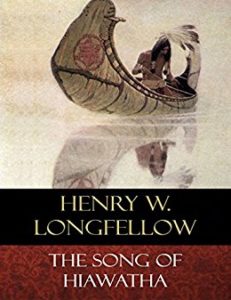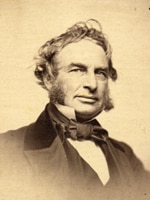
I’ve been reading the epic poems of Henry Wadsworth Longfellow, poems I read as a child and in junior high and high school English classes. These are poems like Evangeline, The Courtship of Miles Standish, and Tales of the Wayside Inn, which includes what is still one of the best-known poems in America, The Midnight Ride of Paul Revere.
The epic Longfellow poem I hadn’t read was The Song of Hiawatha. And I was drawn to it not because I hadn’t read it, but because of an insulting comment aimed in its and Longfellow’s direction. I read an interview with two poets who have both written nonfiction works about the value of poetry. One of them mentioned The Song of Hiawatha as having something that appealed to her, even though it was “to say the least, racially insensitive.”

Hiawatha by Thomas Eakins (8174); Hirschhorn Museum
My first reaction was a question. Why do we feel compelled to politicize everything? My second reaction was to seek out the poem and read it for myself. Having already read three of Longfellow’s epic poems; and discovering that in one of them, Evangeline, that he had done something no one in America had previously done (find the heroic in Catholics); and knowing that the poet had also written poems against slavery which cost him sales of his books in the South, I wondered whether the poem was as “racially insensitive” as the writer seemed to think.
Longfellow published The Song of Hiawatha in 1855. The reviewer for The New York Times hated it, “because there is no romance about the Indians,” and referred to Indians as “a justly exterminated race.” Another reviewer believed Longfellow had plagiarized Nordic legends and transported them to Indians in America. The critics generally hated it, but it was a popular success—people loved it.
But think about those remarks: “because there is no romance about the Indians” and “a justly exterminated race.” It was not Longfellow who was being racially insensitive. He had done something similar to what he had done with Evangeline—he amplified the heroic in native Americans, at a time when they were considered distinctly non-heroic and not entirely human.

On the great Red Pipe-stone Quarry,
Gitche Manito, the mighty,
He the Master of Life, descending,
On the red crags of the quarry
Stood erect, and called the nations,
Called the tribes of men together.
From his footprints flowed a river,
Leaped into the light of morning,
O’er the precipice plunging downward
Gleamed the Ishkoodah, the comet.
And the Spirit, stooping earthward,
With his finger on the meadow
Traced a winding pathway for it,
Saying to it, “Run in this way!”
The Song of Hiawatha is about the origins of Hiawatha and his doomed love for the Dakota maiden Minnehaha. But it is also much more. It is an accounting of the origins of all the native American tribes, based on legends and tales but now brought coherently together in one place and in one narrative. It is a mythology of native American gods. It is a story of origins of geography and people.

Longfellow in 1855
And while it is filled with evil actions and bad characters, it is also filled with nobility of purpose and people acting heroically. In many ways, the poem is the classic struggle between good and evil, and how good and evil thread themselves through the lives of both villains and heroes.
Some of the stories that inspired The Song of Hiawatha came from a tribal chief who visited Longfellow many times in his home. Others came from the poet’s research and meeting other native Americans in Boston.
It’s an enthralling story with strong elements of the mythic, and it is a story about American Indians. No one had written about them in this way before.
To call the poem “racially insensitive” tells us far less about the poem, Longfellow, and the time he lived in, and far more about our own time. The Song of Hiawatha is a beautiful story about a heroic leader who loses what he holds most dear.
Related:
Our Best-Known Patriotic Poem: Longfellow Visits a Church
The Poem as Modern Myth: “Evangeline” by Henry Wadsworth Longfellow
Childhood, Poetry, and History: “The Courtship of Miles Standish”
Photo by Pai Shih, Creative Commons, via Flickr. Post by Glynn Young, author of the novels Dancing Priest and A Light Shining, and Poetry at Work.
__________________________

“I require all our incoming poetry students—in the MFA I direct—to buy and read this book.”
—Jeanetta Calhoun Mish
- “Horace: Poet on a Volcano” by Peter Stothard - September 16, 2025
- Poets and Poems: The Three Collections of Pasquale Trozzolo - September 11, 2025
- Poets and Poems: Boris Dralyuk and “My Hollywood” - September 9, 2025
L.L. Barkat says
Fascinating history, Glynn. 🙂
And your question is a good one. I suppose that every generation brings with it the current perspective—important in its way, for evaluating current events and literature, etc. and perhaps looking at the roots of difficulty by looking backwards to past events and classics.
Yet, that only goes so far, when the current lens is applied to a different age, as you note. (I’ve always had this issue with religious texts as well, where we misapply because we miss the spirit in which they were first written, which is then exacerbated by claiming it is God’s viewpoint in its absolute details rather than in its spirit—that spirit often being quite radical if the text is evaluated in the context of its own place and time).
Now I might have to read Hiawatha! 🙂 (Not sure it was ever part of my education.)
Bethany says
Thank you for bringing “The Song of Hiawatha” and your perspective on it to our attention.
I hear what you’re saying too, L.L., as far as the spirit of something and context. Always important to keep that in mind.
Sandra Heska King says
Thanks for taking us deeper. I’ve only read portions, I think, because Tahquamenon Falls. I should get to know this poem better because of that, because my grand girl is NA. I’m glad for this perspective. I have an old (1937) Best Loved Poems of HWL. I just took it from the shelf. At least I didn’t have to buy it!
Michele Morin says
We “claim” Longfellow here in Maine, and I’ve visited his home — the site of so much sadness and grief for him. I’m glad you’ve come to his defense here, and that you have motivated me to re-acquint myself with some of his work.
Justin Mandosking says
There is a small island in the Upper Peninsula of Michigan caller Sugar Island, its in between the twin Saults. Henery Longfellow visited chief Mendosking there and heard most of the stories there. One can actually walk in the steps of Hiawatha along the shore of Lake Superior.
Justin Mandosking says
Most of the stories in Longfellow’s Song if Hiawatha cane from the lips of Chief Mendosking of the Jim Island Indians. Chase Osborne, visited with Mendoskong learned of Longfellow’s work and published a three page article in the Detroit Freepress.
One of the Beaver totem teachings from the Jim Island Indians is that decisions are macs by all and on behalf of the generations yet unborn (7 generations ahead). Another teachings is that of blood memory, meaning that all of us carry the memories of our ancestors within on our blood.
The song of Hiawatha is an Aadizookaan, a sacred teachings that is played out in the 4 moons of winter. The stories in the Song of Hiawatha are descriptions of celestial movements.
Another very interesting point about the song is that once the true source of the poem is realized the other characters can be known as well. The Chief Black Robe referred to in the Song of Hiawatha is the venerable Bishop Frederick Baraga. In 1861 Chief Mendosking’s father signed a treaty with the Catholic church on Behalf of himself and his community.
The song of Hiawatha is the heritage of the Jim Island Indians and Catholics, its the heritage of the Beaver clan and all Americans.
Brian Thomas Goddard says
I have deep feelings about the ‘Indians’ of the North Eastern Woodlands, and those of the North-West Pacific Coast. To me, Henry Wadsworth Longfellow is a priceless link with the Haudenosaunee; and their great, topographical Longhouse Of Peace; which stands as a testimony for the whole World of people… if only they would listen!